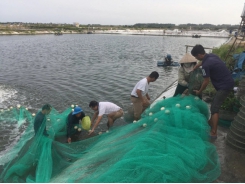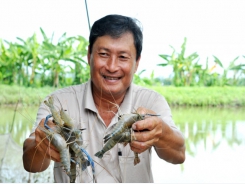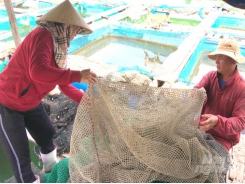Solutions to effectively handle water pollution in shrimp farming

The models of shrimp intercropping with mullet or monogamous tilapia in Binh Dinh show that they can both handle the pollution water sources for farming and increase income.
Water contamination is the main cause of shrimp disease. Photo: Vu Dinh Thung.
Building water filter tank
According to Binh Dinh sub-Department of Fisheries, some shrimp farming areas are yet to be planned, leading to serious water pollution and it is the main cause of shrimp diseases.
Reality shows that the number of spontaneous shrimp farming areas with weak infrastructure has outnumbered those being planned in Binh Dinh. The extensive shrimp farming areas do not have a separate water supply system into the pond and a separate wastewater discharge system, but discharge directly into the environment instead, leading to the spread of pollution.
In the context of seriously polluted farming water, causing continuous disease for shrimp, many households raising white leg shrimp in the form of intensive and semi-intensive farming in Phu My district (Binh Dinh) have filtered water before stream it into ponds.
The water filter tank is built of cement bricks with a width of 6m, a length of 4m, and a depth of 2m. Underneath the tank is a layer of coral rock, followed by a layer of activated carbon and a thick layer of sand on top. Water is pumped from the underground circuit into the filter and then discharged into the pond through a large plastic pipe. Continuous pumping and filter help clear the water and before it pours into the pond and there is little change in algae.
Shrimp owners have to remove the sand and coal layer once every 3-5 months. The 1-year coral layer must also be withdrawn, scrubbed clean, and then put back in the tank to avoid contamination of the water from the scum in the filter tank. The model of using water filter tanks for shrimp farming has been applied by many whiteleg shrimp pond owners in My An commune (Phu My district).
Dual effectiveness with an intercrop of fish with shrimp farming
For shrimp farmers in Hoai Nhon town (Binh Dinh), mullet is raised in shrimp ponds so that the fish can clean the pond environment. The intercropping helps limit environmental diseases on shrimp and brings more income for farmers with fish farming.
Deputy Director of Binh Dinh Agricultural Extension Center Do Minh Quang said that farming households must manage environmental factors during the farming process; regularly monitor watercolor as well as monitor the health and disease status of mullet fish to take timely measures.
“Especially, mullet is omnivorous which mainly eats organic detritus. This feature is very beneficial for cleaning degraded shrimp pond environments. In addition, the technique of raising mullets is not difficult, there are few diseases among those fishes, so the survival rate is high. Raising mullet interspersed with shrimp at a ratio of 1/4 will bring double profits on the same area, and at the same time reduce the time and cost of fish feeding.
Because the shrimp's food is always leftover on the bottom of the lake when the aerator runs on the aeration machine, the excess food pops up, the fish keeps on snapping, so they can take advantage of the refined food source and the fish will grow faster. Raising mullet in degraded shrimp ponds has given double results, which are both benefit the pond’s water environment to ensure safe shrimp growth and creating more income for farmers,” said La Dong Quang, a farmer raising mullet in a shrimp pond in Hoai Nhon town shared.
In the shrimp farming area in the direction of biosecurity in Dong Dien village, Phuoc Thang commune (Tuy Phuoc district, Binh Dinh), in the shrimp ponds, tilapia can be stocked with the density of 1 fish per 2m2 so that they clean the pond bottom and ensure the water source for farming.
“Tilapia not only gradually eat waste at the bottom of the pond to help limit pollution, but the slime layer of the fish also secretes substances with biological effects to kill harmful bacteria of shrimp, balancing the ecology in the pond. Thereby, shrimp farming in Dong Dien in recent years has not been harmed by diseases, farmers can garner more profits," elaborated Pham Van Chay, who has 4,500m2 of water surface area for white leg shrimp farming in Dong Dien village.
Related news
Tools

Phối trộn thức ăn chăn nuôi

Pha dung dịch thủy canh

Định mức cho tôm ăn

Phối trộn phân bón NPK

Xác định tỷ lệ tôm sống

Chuyển đổi đơn vị phân bón

Xác định công suất sục khí

Chuyển đổi đơn vị tôm

Tính diện tích nhà kính

Tính thể tích ao




 Shrimp farming with Semi biofloc technology for dual…
Shrimp farming with Semi biofloc technology for dual…  Environmental pollution of offshore fish farms in urgent…
Environmental pollution of offshore fish farms in urgent…